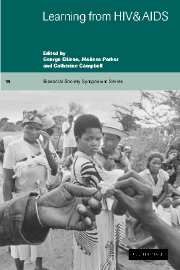Book contents
- Frontmatter
- Contents
- List of contributors
- Foreword by D. Clarke-Patel
- 1 Introduction. Learning from HIV and AIDS: from multidisciplinary to interdisciplinarity
- 2 HIV and the evolution of infectious diseases
- 3 The epidemiology of HIV/AIDS: contributions to infectious disease epidemiology
- 4 The influence of HIV/AIDS on demography and demographic research
- 5 What have clinicians learnt from working with HIV/AIDS? A medical perspective from London
- 6 How has the HIV/AIDS pandemic contributed to our understanding of behaviour change and health promotion?
- 7 Anthropological reflections on HIV prevention strategies: the case for targeting London's backrooms
- 8 An absence of anthropology: critical reflections on anthropology and AIDS policy and practice in Africa
- 9 A disaster with no name: the HIV/AIDS pandemic and the limits of governance
- 10 Postscript: reflections on HIV/AIDS and history
- Country index
- Subject index
- References
6 - How has the HIV/AIDS pandemic contributed to our understanding of behaviour change and health promotion?
Published online by Cambridge University Press: 14 January 2010
- Frontmatter
- Contents
- List of contributors
- Foreword by D. Clarke-Patel
- 1 Introduction. Learning from HIV and AIDS: from multidisciplinary to interdisciplinarity
- 2 HIV and the evolution of infectious diseases
- 3 The epidemiology of HIV/AIDS: contributions to infectious disease epidemiology
- 4 The influence of HIV/AIDS on demography and demographic research
- 5 What have clinicians learnt from working with HIV/AIDS? A medical perspective from London
- 6 How has the HIV/AIDS pandemic contributed to our understanding of behaviour change and health promotion?
- 7 Anthropological reflections on HIV prevention strategies: the case for targeting London's backrooms
- 8 An absence of anthropology: critical reflections on anthropology and AIDS policy and practice in Africa
- 9 A disaster with no name: the HIV/AIDS pandemic and the limits of governance
- 10 Postscript: reflections on HIV/AIDS and history
- Country index
- Subject index
- References
Summary
Introduction
The challenges of HIV prevention, particularly amongst ‘hard-to-reach’ groups in marginalised settings, has highlighted the urgent need for theoretical renewal in the field of the psychology of health promotion. This is particularly the case in relation to understanding how social factors impact on the possibility of health-promoting behaviour change. Psychologists have traditionally sought to explain health-related behaviour in terms of individual-level psychological constructs, usually within the ‘social cognition’ tradition (Conner and Norman, 1995). Within this tradition, behaviour is explained in terms of properties of the individual, such as individual cognitions, behavioural intentions and behavioural skills. Accordingly, first generation HIV-prevention programmes sought to promote sexual behaviour change at the individual level, through providing people with knowledge about sexual health risks, and training them in the behavioural skills necessary for the performance of new behaviours.
However, one study after another has highlighted that people often have unprotected sex with multiple partners despite having the necessary knowledge and skills to protect themselves. In her review of HIV-prevention programmes in a range of low income countries, Gillies (1998) concludes that individual-level approaches are unlikely to change the behaviour of more than one in four people, generally the more affluent and educated. This is because health related behaviours are determined not only by conscious rational choice by skilled and knowledgeable individuals, but also by the extent to which community and societal contexts enable and support the performance of such behaviours (see also: d'Cruz-Grote, 1996; Sumartojo, 2000).
- Type
- Chapter
- Information
- Learning from HIV and AIDS , pp. 148 - 177Publisher: Cambridge University PressPrint publication year: 2003
References
- 1
- Cited by



